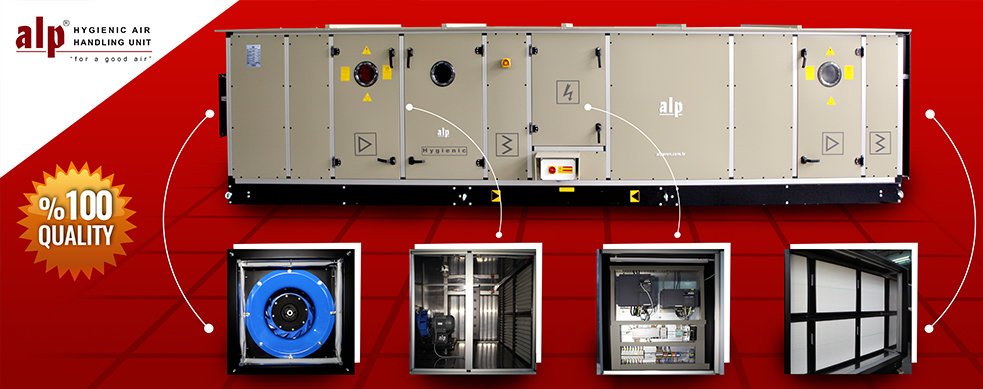
In addition to providing comfort conditions, it is also important to provide hygienic conditions during the heating, cooling and ventilation of areas such as operating rooms, intensive care units, laboratories, food production facilities. In areas that are desired to be hygienic, it is necessary to provide the conditions in accordance with international standards along with the training, organization and management of the personnel. In hygienic areas, necessary attention should be paid to the design of the air conditioning installation required to provide the hygienic air in accordance with the standards, to make the device selection and assembly and to ensure its operation.
With hygienic air conditioning systems, it is possible to keep the microorganism concentration at the specified values, as well as to ensure that the dust and narcosis gases are at the lowest levels. For this purpose, operating rooms, semi and fully sterile areas, material storages, entrance and exit corridors, device rooms, preparation rooms, wake-up rooms, intensive care units, intensive therapy rooms with patients at risk of infection and transport, intensive monitoring rooms, emergency rooms A hygienic air conditioning system should be used in all places that need to be sterile, such as bed rooms of private care departments, bed rooms of premature baby care departments, endoscopy intervention rooms.
The preferred hygienic air conditioning systems should be manufactured in accordance with international standards. The inner and outer walls of the power plant should be designed in a way that they do not form a thermal bridge. Particle accumulation at the joints should be prevented. Its inner surfaces should be made of stainless material and be washable. In the hygienic units, protrusions that may cause dust accumulation should be removed and smooth surfaces should be formed. Equipment inside the cell should be controllable, thanks to the sight glass and interior lighting system. Filter leakage class, number of filters, filter order and body tightness must comply with accepted standards. According to EN 1886, the filter leakage class should be “F9” and the body tightness should be in accordance with the “L2” class. Condensation should be prevented by using antibacterial silicone tape that cuts the contact between the inner and outer walls. It must be manufactured in accordance with VDI 6022-1 / 3, DIN 1946-4 and EN 13053 standards.
H13 or H14 class hepa filters installed after G4, F7, F9 and ultraviolet filters listed in the hygienic unit should be placed inside the room where the hygienic air conditioning system serves, just before the blowing terminal element.
The preferred hygienic air conditioning system should automatically adjust the temperature at 20-23 ° C and relative humidity at 30-60% in operating theaters. Positive pressure should be provided in operating rooms compared to corridors and other neighboring areas. The positive pressure direction between units should be designed to prevent air flow from less clean areas to clean areas. Air filtration of 90% or more should be provided. The hygienic air conditioning system should make a change of filtered air at least 25 times per hour in operating rooms. The minimum amount of fresh air should not be less than 50%. In operating theaters, air should be given from the ceiling area and exhausted from points close to the floor.
Laminar air units should be preferred according to the sensitivity of the surgical field infection risk in surgeries such as heart, brain, orthopedics and prosthesis surgery performed in operating rooms.
Laminar air units are terminal elements that provide ideal ventilation, produced for vertical flow ceilings, operating rooms and similar environments. They provide a terminal velocity between 0.20 m / s and 0.45 m / s and laminar current in the projection of their size. Thanks to the vertical flow and the hepa filters used, which are the most important characteristics, they provide extremely low particle and bacteria counts at the end of the operation. With the hygienic ventilation they create, they reduce the anesthetic gas rate to a minimum.
Laminar air units are mounted on the ceiling of the operating room above the operating table. Laminar air units consist of stainless steel air distribution box, hepa filters, transparent air distributor called laminator and operating room pendant lamp connection. The laminator provides a vertical air flow towards the operating table. Thus, the particles and microorganisms present in the air flow area are immediately removed from the environment and a high-grade cleaning class is provided around the operating table.
The hygienic air conditioning system must automatically adjust the ambient temperature at 21-24 ° C and relative humidity at 40% in intensive care units. The hygienic air conditioning system should make a change of filtered air at least 15 times per hour in intensive care units. The minimum amount of fresh air should not be less than 50%. Air filtration of 90% or more should be provided.
Isolation rooms ventilated with hygienic air conditioning system should be used at negative or positive pressure depending on the intended use. There should be a pressure difference of at least 2.5 Pa between the isolated patient room and the areas outside the room, and 15 air changes per hour should be provided. In negative pressure isolation rooms, the part where the patient is is considered as dirty. The patient room should be kept at negative pressure compared to the areas outside the room. Recirculation of room air inside the hospital should be prevented and the air should be vented outside the hospital. In this way, both the microorganism load in the room is reduced and the spread of polluted air to other parts of the hospital is prevented. If the air leaving the room is to be recirculated, it must be passed through an external hepa filter. In order to prevent air leaks in negative pressure rooms, the room must be well insulated and sealed. Ambient temperature should be 21-24 ° C and relative humidity should be 30-60%. Air filtration of 90% or more should be provided.
The hygienic air conditioning system, which is used in the sterile areas of hospitals such as operating rooms and intensive care units, should also be used in all other units such as patient rooms, corridors, waiting rooms, examination rooms. In other words, the use of hygienic air conditioning system in all units of our hospitals, whose importance is increasing day by day in the fight against the pandemic, is essential for the health of employees and patients.
İlker KURAN
Alperen Ltd Şti







